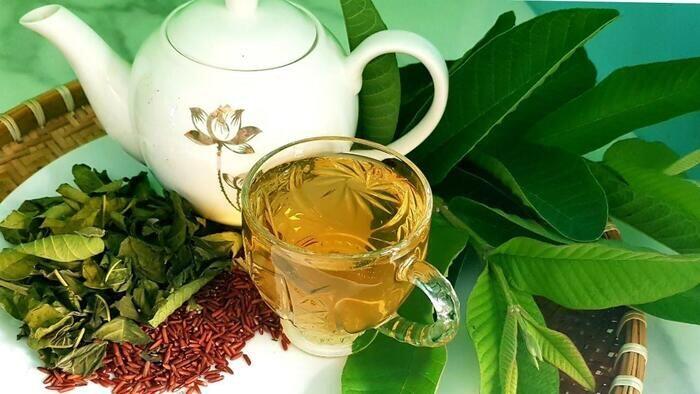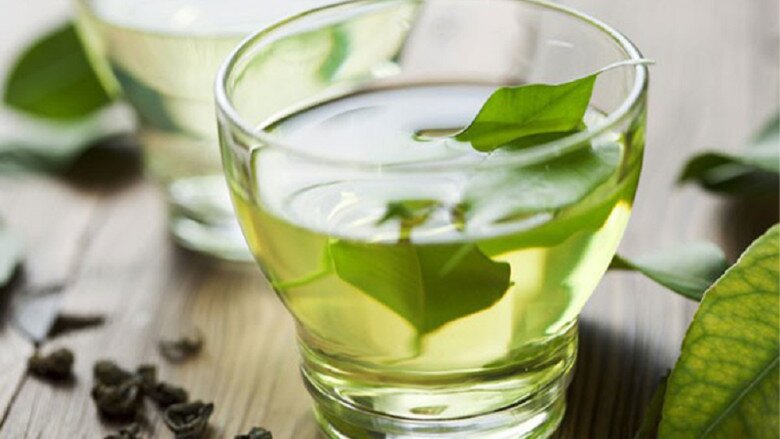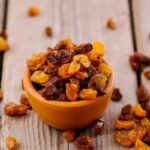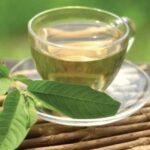Diabetes is often caused by a combination of genetic and lifestyle factors, including an unhealthy diet, excessive sugar and fat intake, insufficient fiber, and lack of exercise. Doctors warn that diabetes can lead to serious complications and early intervention is crucial.
In addition to medication, diabetes treatment requires lifestyle and dietary changes. According to Ths.BS Pham Khanh Toan, Head of the Department of Traditional Medicine at the Central Military Hospital 108, diabetes can be treated with or without medication in Traditional Eastern Medicine. The non-medication approach utilizes natural therapies, including herbal teas brewed from vegetables, fruits, and leaves.
Two commonly used leaves in Eastern medicine for diabetes treatment are guava and vối leaves. These leaves are abundant in Vietnam.

Guava leaves have been shown to help manage diabetes. Illustration.
Guava Leaves
According to Nguyen Tri Phuong Hospital, guava leaves have a bitter taste and a warming effect. They are commonly used in folk medicine for their detoxifying, anti-edema, and hemostatic properties in treating diabetes. Guava leaves contain approximately 7-10% tannins, about 3% guava resin (containing d-galactose, d-galacturonic acid), and 0.31% guava leaf essential oil (including polyphenols, sitosterol, saponins, guijavalic acid, maslinic acid, etc.).
In 2018, Japanese scientists conducted a study on the effects of guava leaves on type 2 diabetes, published in the journal Nutrition & Metabolism. The study found that the flavonoids in guava leaves help lower blood sugar levels by improving glucose utilization by peripheral tissues. Additionally, the Alpha-glucosidase enzyme in guava leaves aids in food breakdown, thereby reducing blood sugar levels. The juice of young guava leaves stimulates the activation of protein tyrosine phosphatase 1B, helping to stabilize blood sugar levels.
The following herbal recipe supports diabetes treatment in Eastern Medicine: Take 5-10 fresh guava leaves and rinse them under running water. Boil 1.5 cups of water (350 ml) in a pot over medium heat for 2 minutes. Then, add the guava leaves and boil for 5 minutes. For easier drinking, you can add ½ teaspoon of regular tea leaves. After boiling for 10 minutes, add water and filter the mixture.
Alternatively, you can rinse 2-3 guava leaves and chew them on an empty stomach in the morning. This practice is beneficial for diabetics. Dried and powdered guava leaves can also be consumed.
However, it is important to consider the potential side effects and duration of guava leaf consumption for effective diabetes management.
Vối Leaves
According to Poly-Doctor Bui Dac Sang, of the Vietnam Academy of Science and Technology and the Hanoi Oriental Medicine Association, vối is a commonly cultivated plant in Vietnam. Its buds and leaves are used for brewing tea, offering health benefits and treating various ailments.
The primary constituents of vối buds and leaves include tannins, polyphenols, flavonoids, triterpenes, alkanoids, and minerals. They also contain approximately 4% essential oil, imparting a pleasant aroma. Fresh or dried vối leaves are used to treat skin conditions such as scabies and boils.

Vối leaves also contain compounds that help prevent and manage diabetes. Illustration.
Additionally, scientists have discovered and proven the efficacy of vối leaves in preventing and treating diabetes. A recent clinical trial conducted by the Institute of Nutrition in collaboration with Japan Women’s University found that consuming vối tea continuously for three months, with an average daily intake of 20-25 grams per person, effectively reduced blood sugar levels in type 2 diabetic patients.
According to Nguyen Tri Phuong Hospital, the flavonoids in vối flower buds help stabilize blood sugar and reduce blood fat levels. Drinking vối leaf tea can help prevent diabetes: use 20-30g of vối leaves for brewing or decocting per day.
However, doctors advise against consuming excessive amounts of vối leaf tea. It is recommended to drink only one pot or one glass per day. Vối leaf tea should not replace water, as it may impact the excretory system. Additionally, avoid drinking vối leaf tea on an empty stomach, and do not consume overly strong brews, as they may cause fatigue, energy loss, and dizziness.
When using vối leaves to manage diabetes, it is advisable to consult a doctor and combine their use with a scientific diet and regular exercise for optimal results.






































